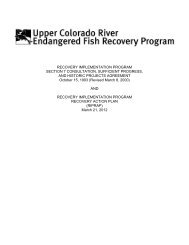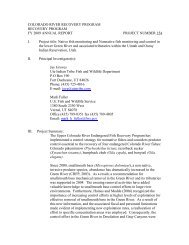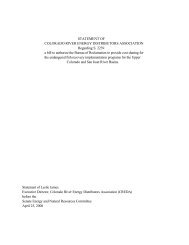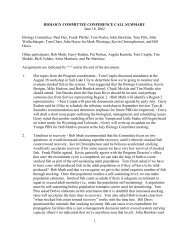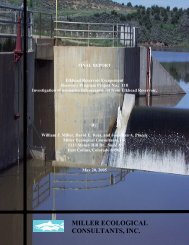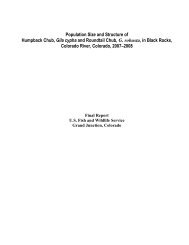K. R. Bestgen, K. A. Zelasko, and G. C. White. Monitoring ...
K. R. Bestgen, K. A. Zelasko, and G. C. White. Monitoring ...
K. R. Bestgen, K. A. Zelasko, and G. C. White. Monitoring ...
Create successful ePaper yourself
Turn your PDF publications into a flip-book with our unique Google optimized e-Paper software.
• Determining origin of untagged fish, whether hatchery-reared or wild, would aid in<br />
determining recruitment rates of razorback suckers.<br />
• Simulations are useful to guide assignment of minimal levels of sampling effort to<br />
accomplish goals of parameter estimation.<br />
• Rigorous data analysis is needed to evaluate whether sampling efforts for larger juvenile<br />
<strong>and</strong> adult razorback sucker are effective at improving accuracy <strong>and</strong> reliability of<br />
abundance <strong>and</strong> survival estimates in the future.<br />
RECOMMENDATIONS<br />
• Maintain present sampling to monitor timing of presence <strong>and</strong> abundance of razorback<br />
sucker larvae <strong>and</strong> juveniles in the middle <strong>and</strong> lower Green <strong>and</strong> Colorado rivers.<br />
Minimally, high quality <strong>and</strong> close-up digital photographs should be taken of questionable<br />
specimens that include the lateral view of the body as well as the ventral view of the<br />
mouth, <strong>and</strong> in some cases, specimen preservation in appropriate solutions should be<br />
considered.<br />
• Maintain sampling for larvae in the lower <strong>White</strong> River where reproduction was<br />
documented for the first time in 2011 at levels outlined in project 22f. Sampling should<br />
be evaluated in the future (after 3 more years) <strong>and</strong> adapted to presence <strong>and</strong> abundance<br />
patterns noted.<br />
• Conduct additional but relatively limited fine-mesh seine sampling in the lower Yampa<br />
River for razorback sucker larvae within 1–2 weeks after first appearance of middle<br />
Green River larvae.<br />
• Maintain sampling for razorback sucker larvae in the Colorado River in accordance with<br />
plans to evaluate razorback sucker reproduction in the lower Gunnison <strong>and</strong> Colorado<br />
rivers per project 163, perhaps adding light trap sampling in gravel pit ponds <strong>and</strong> other<br />
appropriate areas. When higher levels of reproduction there are noted, revise the<br />
monitoring program to incorporate new information on distribution of larvae relative to<br />
spawning areas <strong>and</strong> establishment of sentinel sites that can be used to monitor timing of<br />
reproduction <strong>and</strong> population abundance over time.<br />
50




